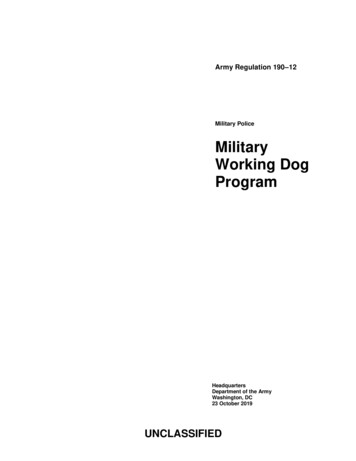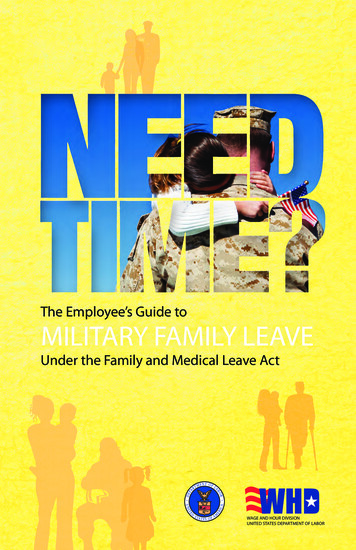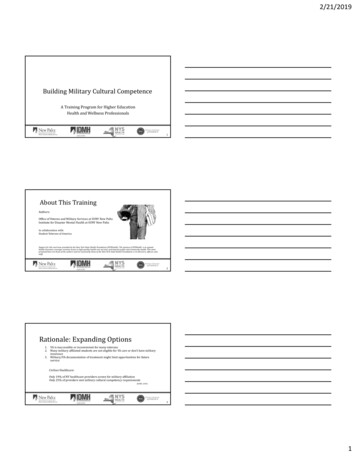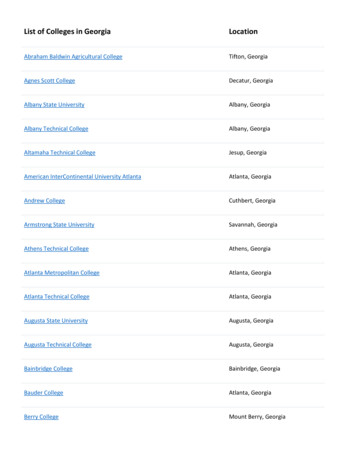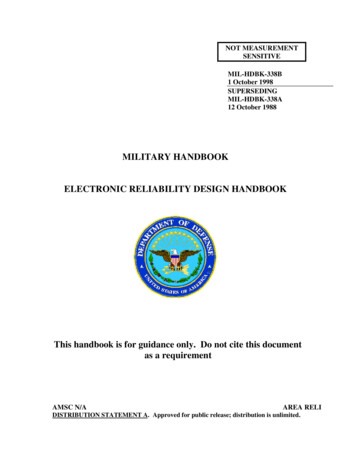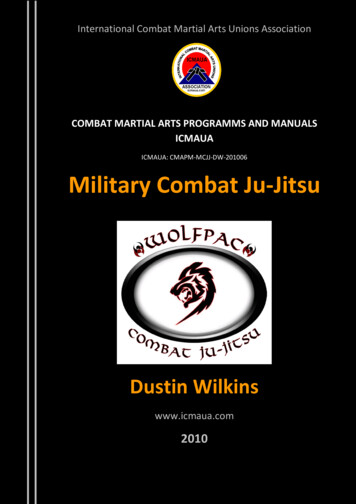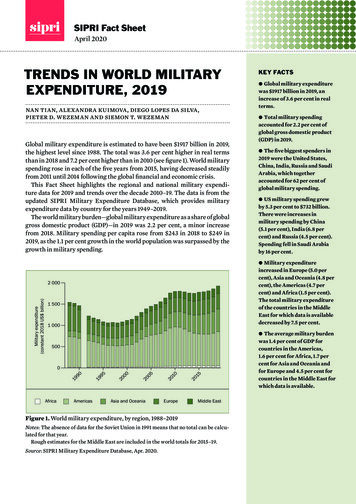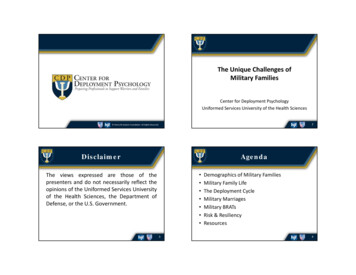
Transcription
The Unique Challenges ofMilitary FamiliesCenter for Deployment PsychologyUniformed Services University of the Health Sciences2DisclaimerAgendaThe views expressed are those of thepresenters and do not necessarily reflect theopinions of the Uniformed Services Universityof the Health Sciences, the Department ofDefense, or the U.S. Government. 3Demographics of Military FamiliesMilitary Family LifeThe Deployment CycleMilitary MarriagesMilitary BRATsRisk & ResiliencyResources4
Family DemographicsTotal Force Personnel & Family MembersDemographics of Military FamiliesFamilyMembers(n 3,066,717)57.9%“When one person joins the militarythe whole family serves.”5Marital Status Dependents––––Total Force Marital StatusSpouseChildrenStepchildrenSame‐Sex Spouses* Non‐DependentsParentsSiblingsExtended familyAdult children62012 Demographics ProfileMilitary Families––––MilitaryPersonnel(n 2,228,348)42.1%Single(n 1,056,112)47.4%U.S. Marine Corps photo byLCPL Jacob BarberPhotos: http://www.defense.gov; http://www.defenseimagery.milMarried toCivilian(n 1,062,700)47.7%Dual Military(n 109,536)4.9%U.S. Army photo by SSG Ben Navratil72012 Demographics Profile8
Estimated Divorce TrendsEstimated Divorce TrendsEstimated Percentage of Divorcesby Service Branch Trends (Active Duty): 2000‐2012Estimated Percentage of Divorcesby Reserve Component Trends (Selected Reserve): 2000‐201292012 Demographics ProfileParental StatusAge of Military SpousesActive DutyTotal Force Parental StatusMilitaryPersonnelwithoutChildren(n 1,258,112)56.5%2012 Demographics Profile102012 Demographics Profile41 orolder13.5%MilitaryPersonnel withChildren(n 970,236)43.5%36 to 4013.4%31 to 3519.5%1125 oryounger28%26 to 3025.5%Selected Reserve41 orolder32.4%36 to 4016.1%25 oryounger13.3%26 to 3019.7%31 to 3518.5%122012 Demographics Profile
Age of Military ChildrenActive DutySelected Reserve19 to 224.4%19 to 2211.9%12 to 1822.4%0 to 542.4%6 to 1130.8%Military Marriages0 to 529.3%12 to 1829.1%“If the Navy wanted you to have a wife,they would have issued you one.”6 to 1129.7%13142012 Demographics ProfileMarriage and Divorcein the MilitaryMilitary MarriagesUnique attributes of military marriages: Marriage/divorce rates Young marriagesWhen the military calls, the Service Member must goSeparation is standardReunification is also a normal occurrenceSeparation from family/friends is commonDevries et al. (2012) Marital quality Infidelity15Adler‐Baeder et al. (2005); Hogan & Seifert (2010); Karney & Crown (2007); Karney et al. (2012); Negrusa et al. (2014);Riviere et al. (2012); Schumm et al. (2012); Snyder et al. (2012); Photo by AzureCitizen: http://en.Wikipedia.org/wiki/Saber arch16
The Good and Bad of LongDistance RelationshipsBad Equivalent relationship satisfaction No greater risk of infidelity Often successful despite difficulties and distance Increased resilience and sense of self‐efficacy25% ReportingInterpersonal ConflictGoodImpact of Deploymenton Couples Mild depression common Tendency to isolate Difficult to communicate Difficult to maintain connectionPDHA20PDHRA151050Active Duty17Guldner (2003)Evidence-Based CouplesCounseling in the DoD/VAReserve Component18Millilken et al. (2007)Gottman’s Basic Tenets Gottman Method Couples TherapyHappy Marriages Based on deep friendship Use of repair attempts Shared sense of deep meaning Most marital argumentscannot be resolved– http://www.gottman.com– http://csf.army.mil Emotionally Focused Therapy for Couples (EFT)– http://www.iceft.com– http://www.strongbonds.org Integrative Behavioral Couples Therapy (IBCT)– http://www.ibct.psych.ucla.edu– http://drandrewchristensen.com19Gottman & Silver (1999)20
Gottman’s “SoundRelationship House” TheoryCreate SharedMeaningManage ConflictThe Positive PerspectiveTurn Towards Instead of AwayShare Fondness & AdmirationCommitmentMake LifeDreams ComeTrueTrustThe Four Horsemenof the ngBuild “Love Maps”Gottman & Gottman (2008); Stanley (2013); http://www.gottmanblog.com21Gottman & Gottman (2008); WRAIR (2011)22Impact of Military Culture Following OrdersMilitary Family Life Leadership Communication Style“Military families are families withunique challenges.” “Mission First”23Devries et al. (2012)24
“Greedy Institutions”Family StressorsBoth the military andfamilies demand:– Commitment– Loyalty– Time– EnergyNormative Occur for most families ExpectedNormativeMilitary Occur for most military families ExpectedCatastrophic25Blaisure et al. (2012); Segal (1986) Do not occur to most families UnexpectedBlaisure et al. (2012)26Normative Stressors ofMilitary Family Life Frequent relocations (PCS) Spouse employment opportunitiesIf you knew you had to move your entirehousehold every 2‐3 years, how would youlive your life differently than you do now? Separations Deployments Risk of injury or deathBlaisure et al. (2012); Lim & Schulker (2010)27Blaisure et al. (2012), p. 5728
Emotional Cycle ofDeploymentPre‐DeploymentPost‐DeploymentThe Deployment CycleDeploymentRe‐Deployment2930Pincus et al. (2001)MilSpouseCycle of DeploymentPatricia Santiago (2010)SustainmentParentingCycle of ymentLookingAheadParenting(War Zone /Home Front)FacingRealitySayingGoodbyeSurviving theHomeStretchMovingForwardDeVoe & Ross (2012)32
Emotional ReactionsGriefPre‐Deployment StageDetachmentPre‐Deployment“A holding pattern during which lifecannot yet begin.”Conflict33DeVoe & Ross (2012)ParentingHelping Families Facilitate communication Looking Ahead– Sharing of feelings– Discussion of expectations– How/when to communicate with children aboutimpending departure– Handling feelings & responding to children Saying Goodbye– Importance of saying goodbye face‐to‐facePre‐DeploymentDeVoe & Ross (2012)34DeVoe & Ross (2012)35 Foster connectionTeach positive coping skillsEmphasize the importance of supportHelp couples address practical issuesDiscuss parenting issuesPavlicin (2003); Pincus et al. (2001)Pre‐Deployment36
Themes for Therapy Affective Education Exploring RolesDeployment Stage Exploring UnresolvedConflicts“Repeat after me I can do this.” Expectations of FidelityPre‐Deployment37Laser & Stephens (2012)38Emotional ReactionsParenting Deployment Parenting from the Home Front– Disorientation, mixed emotions– Relief that anticipation is over– Increased responsibilities increased stress Parenting from a War Zone Sustainment– Relinquishment of daily involvement– Adaptation of new strategies– Self‐growth, independence– Less angry, but lonelier Surviving the Home Stretch Re‐Deployment (Anticipation of Return)– Excitement, apprehensionDeVoe & Ross (2012); Pincus et al. (2001)– How will children respond to reunion?DeploymentDeployment39DeVoe & Ross (2012)40
Impact of Deploymenton ChildrenSigns of Distressin Children Emotional / Behavioral Difficulties Cumulative Months ofDeployment Child MaltreatmentU.S. Army photoAgeBehaviorsMoodsInfantsChange in eating/sleepingListlessnessToddlersCrying, tantrumsIrritability, sadnessPre‐SchoolersClinginess, potty accidentsIrritability, sadnessSchool Age ChildrenBody aches, whining,problems at schoolIrritability, sadnessAdolescentsIsolation, drug useAnger, apathyDeploymentDeployment41Cederbaum et al. (2013); Chandra et al. (2011); Flake et al. (2009); Gibbs et al. (2007);Lester et al. (2010); Rentz et al. (2007); Photo: http://www.defense.govHelping Families 42Military OneSource (2012); Pincus, et al. (2001)Themes for Therapy Deployment:Stress ReductionFacilitate setting personal goalsEncourage creation of a support networkTeach stress management techniquesHighlight the importance of self‐care Sustainment:Resilience & Growth Re‐Deployment:Expectation ManagementDeploymentPavlicin (2003)Deployment43Laser & Stephens (2012)44
Emotional ReactionsReunionPost‐Deployment StageReintegration Elation Relief Frustration“Hello, Stranger.Let’s cohabit and raise these kids.” Tension Resentment ComfortPost‐ Deployment45Sanderlin (2012)46Logan (1987); Pincus, et al. (2001)ReintegrationChallengesParenting Facing Reality– Reconnect & rebuild parent‐child relationships– Role negotiation / co‐parenting challenges Moving Forward– Re‐establish equilibrium– Develop new routines– Incorporate legacy of deploymentFamiliesService Members New routines /responsibilities Loss of independence “Walking oneggshells” Things are notperfect Make meaning ofdeployment Grieve loss of friends Acclimate to civilianlife Re‐adjust to being aspouse/parentPost‐ DeploymentDeVoe & Ross (2012)47 SM will seemdifferent Family willseem different Feelings ofresentment Role/boundaryre‐negotiationPost‐ DeploymentMorris (2008); Pavlicin (2003); Pincus, et al. (2001)48
FacilitatingSuccessful ReunionsThemes for TherapyService pist’s Role(how to help)Isolate vs. great sex 24/7Fairy‐tale reunionSet realisticexpectationsImmediate return to “old ways”New routinesRemind thatadjustment takes timeSeparated from familyEarned a breakStress that both madesacrificesNo one understandsDrill with questionsTeach communicationskills Opening Communication49Military OneSource (2012); Pavlicin (2003) Revisiting Family Roles Creating Opportunities forAppreciation and CaringPost‐ Deployment50Laser & Stephens (2012)Normative MilitaryStressors for Children Relocation Child CareMilitary BRATs EducationBrave, Resilient, Adaptable, Trustworthy Deployments51Blaisure et al. (2012)52
Resiliency inMilitary Children Helping Children:Pre-Deployment Encourage quality time with each child Emphasize honesty Help parents providereassurance Foster connection Create communication planU.S. Navy photo Facilitate conversationsby PO2 Stephanie Tignerwith schools/teachersSense of belonging/communityAdaptableTolerant of diversityResponsible/independentRespect for authorityPre‐Deployment53Easterbrooks et al. (2013); Hall (2012); Park (2011)Helping Children:DeploymentSuccessful Reunionswith Children Encourage consistency & routine Highlight the importance of support fromother adults Help parents model self‐care Facilitate good communication Emphasize the importance of fun Remind parents to let kids be kidsThings to remember:– Children react differently to homecoming dependingon their age & relationship with deployed parent– Children are often loyal to the parent that staysbehind– Children may feel anxious about the ServiceMember leaving again– Children will wonder if rules at home will changePost‐ DeploymentDeploymentHall (2008); Pavlicin (2003)54Military OneSource (2012); Pavlicin (2003); Photo: http://www.defense.gov55Pavlicin (2003); Pincus et al. (2001)56
Infant/ToddlerDevelopmentReunion & Reintegration:Infants/ToddlersdevelopmentalDerenne (2008); Photo: http://www.morguefile.com57 “Stranger Reaction” Increased sensitivity Crying, clinginess,disrupted schedule Delayed milestones Temper tantrums Nightmares Regression in skillsPre-SchoolerDevelopmentRealistic expectationsDirect contactConsistencyOpportunities forconnection Take things slowly Expect regression58Reunion & Reintegration:Pre-SchoolersHomecoming Reactions Growth/development continue at a rapid pace The child’s perception is that everythingrevolves around him/her Magical thinkingpredominatesDerenne (2008); Photo: http://www.morguefile.com Barnett et al. (2012); Photos: http:///flickr.com/photos/thenationalguard, http://www.beaufort.marines.mil59 Personalize stressRegression in skillsActing outTime to warm upFostering Reintegration Attachment is a majormilestoneHomecoming Reactions– Physical– Cognitive (language skills)Fostering Reintegration A time of rapid growth and development Ignore regressivebehaviors Listen & answerquestions Opportunities forconnection Take things slowlyBarnett et al. (2012); Photos: http:///flickr.com/photos/thenationalguard, http://www.beaufort.marines.mil60
School AgeChild DevelopmentReunion & Reintegration:School Age ChildrenHomecoming Reactions– Mastery in academics,athletics, art– Negotiation of status in thepeer group Increased organization,responsibility, cognitive and moral development– Logical thinking, empathy, respect for rules61AdolescentDevelopment62Reunion & Reintegration:AdolescentsHomecoming Reactions Puberty Increased reliance on peer group to determinenorms– Separation/individuation Capable of abstractthinking Common to haveparent/child tensionDerenne (2008); Photo: http://www.morguefile.com Slowly transitionroles/responsibilities Include ServiceMember in routines One‐on‐one time Connect to school/community resourcesBarnett et al. (2012); Photos: http:///flickr.com/photos/thenationalguard, http://www.beaufort.marines.mil63 Emotionally guardedActing outLower gradesReliefConcern about roles/responsibilities SensitivityFostering ReintegrationDerenne (2008) Whiny, aggressive,irritable Need time to talk Need physicalattention Rapid mood shifts Excitement FearFostering Reintegration Physical development slows The child begins to find his/her place in the world Open communication Consistency Transitionroles/responsibilities One‐on‐one time Respect privacyBarnett et al. (2012); Photos: http:///flickr.com/photos/thenationalguard, http://www.beaufort.marines.mil64
Deployment Risk Factors Rigid coping style History of familydysfunction/behavioral healthproblems Families experiencingfirst militaryseparation New to duty locationRisk & Resiliency“Semper Gumby”65Blount et al. (1992); Darwin (2012); Hall (2008) Huffman & Payne (2006); Kelley (2006);Weins & Boss (2006); Wolpert et al. (2000)Blended Families66Selected Reserve Families Children of different developmentalages and stages Higher risk of emotional / behavioral problems Torn between biological parents Two households Issues of isolationAdler‐Baeder et al. (2005); Hall (2008)Young familiesPregnant spousesSingle parent familiesDual military familiesFamilies with foreignspouses Blended families Selected Reserve Exist primarily within civilian community Isolated from traditional military culture,support, and resources Possible financial challenges Employment concerns Changes in health care Yellow Ribbon Program67Darwin (2012)68
The Impact ofMental Health IssuesLGB Families 20 September 2011 Repeal of DADT 26 June 2013 Repeal of Section 3 of DOMA Depression, PTSD Caregiver Burden Prejudice/Discrimination Identity Concealment Relocation Issues Social Support “As goes the parent,so goes the child”Photo Credit: Ms. Britney L. Walker, Army Medicine69Ender et al. (2012); Herek (2009); Oswald & Sternberg (2014); Photo: http://www.army.milBlaisure et al. (2012); Blow et al. (2013); Flake et al. (2009); Goff et al. (2007); Lester et al. (2010);Sayers et al. (2009); Tanielian et al. (2013); Photo: http://www.madison.va.govFamily Belief SystemsKeys to Family ResilienceFamily municationProcessesMaking meaningof adversityFlexibilityClarityPositive outlookConnectednessOpen emotionalexpressionTranscendence &spiritualitySocial & economicresourcesCollaborativeproblem solvingWalsh (2006)70 Viewing crises as a sharedchallenges Normalize/contextualize distress Hope, optimism Affirmation of strengths Making the best of availableoptions Connection with cultural/religions traditions71Walsh (2006)72
FamilyOrganizational PatternsFamilyCommunication ProcessesClear, consistent messagesSharing of informationOpen communicationMutual trust, empathy, andtolerance Creative brainstorming Shared decision‐making/conflict resolution Preparing for future challengesAdaptive changeStability through disruptionsAuthoritative leadershipSupport/collaborationRespect for individual needsConnection to kin/socialnetworks Financial security 73Walsh (2006)DeploymentResiliency Factors Resiliency SkillsFamily readinessActive coping styles“Making meaning” of the deploymentStrong community of social supportAcceptance of military lifestyleOptimismSelf‐relianceAbility to adopt flexible gender rolesHammer et al. (2006); Patterson & McCubbin (1984); Rosen et al. (1993); Walsh (2006); Weins & Boss (2006)74Walsh (2006)Mind‐Body SkillsCognitive SkillsCommunication Skills75Bowles et al. (2012)76
Cognitive SkillsMind-Body Skills Identification of faulty/unhelpfulways of thinking (cognitive distortions)Strengthen the ability to managestress and intense emotions – Mind reading– “Should” statements– LabelingBreathing ExercisesYogaMindfulnessMeditationGuided Imagery Development of alternative, more realisticthoughts (cognitive reframing) Changes in thoughts can lead to changes inbehaviors and in emotion.77Bowles et al. (2012)78Bowles et al. (2012)Communication SkillsHelp resolve problems and maintain connection Speaker‐Listener TechniqueGentle StartupsAvoid the “Four Horsemen”Use of Repair AttemptsGive complimentsFoster friendshipBowles et al. (2012)Resources7980
ResourcesDepartment of Defense2012 Demographics Profile ofthe Military Communityhttp://www.militaryonesource.mil/Search for “Reports” After Deployment: http://www.afterdeployment.org/Families Overcoming Under Stress (FOCUS): http://www.focusproject.org/Military Child Education Coalition: http://www.militarychild.org/Military Family Research Institute: https://www.mfri.purdue.edu/Military Kids Connect: https://militarykidsconnect.org/Military One Source: http://www.militaryonesource.mil/Military Partners & Families Coalition: http://www.milpfc.org/Military Youth Deployment Support Resources & Videos: http://bit.ly/1bveHEhReal Warriors: http://www.realwarriors.net/Talk, Listen, andactivities/toolkits/tlcYellow Ribbon Program: http://www.yellowribbon.mil/Zero to Three: http://www.zerotothree.org/81FOUCS: FamiliesOvercoming Under StressMilitary OneSource Confidential services available via telephone &online Comprehensive information on every aspect ofmilitary life:–––––– Training in core resilience skills– Emotion regulation– Communication– Problem solvingDeploymentReunionRelationshipsGriefSpouse employment & educationParenting & childhoodhttp://www.militaryonesource.mil82– Goal‐settingImage courtesy of: �monday‐project‐focus/– Managing deployment reminders FOCUS World (online resiliency training) FOUCS On the Go! (mobile app)83http://www.focusproject.org84
FOCUS WorldMilitary Kids Connect Online community for militarychildren (ages 6‐17) Access to age‐appropriateresources to support childrendealing with the challenges ofmilitary life Additional resources for parents itarykidsconnect.dcoe.mil86Sesame Street Toolkit:Talk, Listen, ConnectMilitary Kids Connect DVDs: Deployment, Homecomings, Grieving Website: Military Families Near & Far Mobile Apps:– Sesame Street for Military Families– The Big Moving ities/toolkits/tlc88
CDP Website:Deploymentpsych.orgOnline LearningFeatures include:The following online courses are located on the CDP website �coursesNOTE: All of these courses can be take for free or for CE Credits for a fee Descriptions and schedules of upcomingtraining events Blog updated daily with a range ofrelevant content Articles by subject matter expertsrelated to deployment psychology,including PTSD, mTBI, depression, andinsomnia Other resources and information forbehavioral health providers Links to CDP’s Facebook page andTwitter feedCognitive Processing Therapy (CPT) for PTSD in Veterans and Military Personnel (1.25 CE Credits)Prolonged Exposure Therapy for PTSD in Veterans and Military Personnel (1.25 CE Credits)Epidemiology of PTSD in Veterans: Working with Service Members and Veterans with PTSD (1.5 CE Credits)Provider Resiliency and Self‐Care: An Ethical Issue (1 CE Credit)Military Cultural Competence (1.25 CE Credits)The Impact of Deployment and Combat Stress on Families and Children, Part 1 (2.25 CE Credits)The Impact of Deployment and Combat Stress on Families and Children, Part 2 (1.75 CE Credits)The Fundamentals of Traumatic Brain Injury (TBI) (1.5 CE Credits)Identification, Prevention, & Treatment of Suicidal Behavior in Service Members & Veterans (2.25 CE Credits)Depression in Service Members and Veterans (1.25 CE Credits)All of these courses and several others are contained in the Serving Our Veterans Behavioral Health Certificateprogram, which also includes 20 hours of Continuing Education Credits for 350.89Provider Support90How to Contact UsCDP’s “Provider Portal” is exclusively for individuals trained bythe CDP in evidence-based psychotherapies (e.g., CPT, PE, and CBT-I)Center for Deployment PsychologyFeatures include: Consultation message boards Hosted consultation calls Printable fact sheets, manuals,handouts, and other materials FAQs and one‐on‐oneinteraction with answers fromSMEs Videos, webinars, and othermultimedia training aidsDepartment of Medical & Clinical PsychologyUniformed Services University of the Health Sciences4301 Jones Bridge Road, Executive Office: Bldg. 11300‐602Bethesda, MD 20813‐4768Email: General@DeploymentPsych.orgWebsite: DeploymentPsych.orgFacebook: http://www.facebook.com/DeploymentPsychTwitter: @DeploymentPsychParticipants in CDP’s evidence‐based training will automaticallyreceive an email instructing themhow to activate their user nameand access the “Provider Portal”section at Deploymentpsych.org.9192
Military Marriages Unique attributes of military marriages: When the military calls, the Service Member must go Separation is standard Reunification is also a normal occurrence Separation from family/friends is common 15 Devrieset al. (2012) Marriage and Divorce in the Military 16 Marriage/divorce rates



